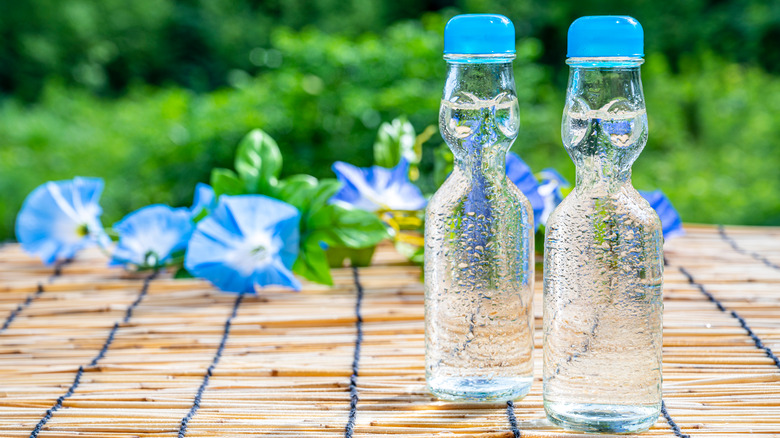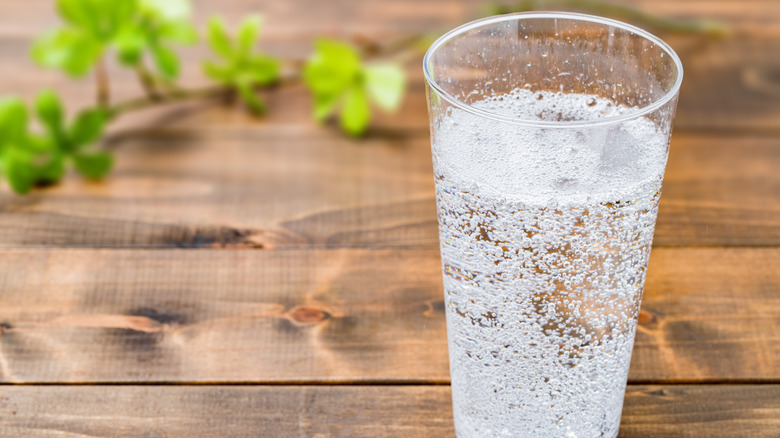Ramune: The Japanese Lemon Soda With A Marble In It
Japan has long been considered a must-visit foodie destination, known for its impeccable presentations, use of regional ingredients, and emphasis on artistry. The Japanese culinary scene is undoubtedly unlike any other. So, it makes sense that Japan's number one soda has a one-of-a-kind taste plus a distinctive, marble-sealed bottle.
Ramune is to Japan what Coca-Cola is to the United States. It's a commonplace drink that can be found just about anywhere in the country, from street-side vendors to nearly all convenience stores. This fizzy drink's name comes from the English word for lemonade, as the first versions of this soda were based on the popular American drink, though, classic ramune doesn't exactly capture that classic lemon taste. The flavor is difficult to describe — something like a citrusy bubble gum — yet instantly recognizable. As the taste is so distinctive companies are able to sell popular ramune-flavored candies, and the taste is evident right away. Today the ramune lineup has grown to embrace a myriad of other flavors from strawberry to melon to lychee. On top of its unique flavor, ramune is instantly recognizable for its bottle, which is sealed with a marble.
So, where did this unique drink (and its distinctive bottle) come from? Although ramune is now considered quintessentially Japanese, it was actually invented by a Scottish man.
History of ramune
In what is today Kobe, Japan, a Scottish pharmacist named Alexander Cameron Sim invented the first version of ramune in the late 19th century. When the drink was initially released, it was first called "mabu soda" or marble soda in Japanese. Fittingly, since it was invented by a pharmacist, the drink was originally used for medicinal purposes rather than cooling down on hot summer days. It was thought the soda could prevent one from contracting cholera. However, the drink eventually caught on for taste alone, and the ramune craze was born.
Today, ramune can be found internationally, and there are dozens of flavors to choose from. Less than a decade ago, it would have been difficult to source this drink in the United States. You would have likely had to go to specialty Asian markets, but today many big-box stores carry the increasingly popular drink in their Asian aisles. They're also easy to find online, and bottles can be shipped to your doorstep.
While the special taste of ramune clearly drives its popularity, it wouldn't quite be itself without its iconic marble-sealed soda bottle, which is a piece of history itself.
Why is ramune sealed with a marble?
A classic ramune bottle features a Codd-neck design and is sealed with a marble. While some ramunes can be bought with a more basic screw cap, the soda is known for this unique feature. You may be wondering about the purpose of including the marble on most ramune drinks, and — while some may see it as a more playful but useless feature — it actually has a purpose. Decades ago, Codd-neck bottles with marbles were actually standard on soda bottles as a way to retain their carbonation, according to the BBC. This method was widely used until the 1930s. However, even as technology advanced, Japan kept this classic design around.
The marble-sealed bottle can be intimidating to open, but with some practice anyone can open it like a pro. Each bottle comes with a little plastic plunger, pop it out from the rest of the cap, place it over the seal, and firmly push the marble into the bottle; you'll be sipping sweet carbonation in no time! Because of indentations in most ramune bottles, the marble is caught in the bottleneck preventing it from rolling around too much while you sip on your soda. To many, it's a quintessential part of the ramune experience. However, if you'd rather not bother sourcing Japanese ramune bottles for yourself, it's also an easy drink to make at home.
The ingredients in ramune and how to make it
Ramune is made of very simple ingredients, and anyone can make this soda at home. A homemade version will only have you needing carbonated water for a base, along with simple syrup and sugar for sweetening. If you're after a classic flavor, including lemon juice is a good idea. However, you can attempt to replicate any of your favorite ramune flavors using orange, peach, yuzu, and even matcha infusions. In our book, all are good ideas. With plenty of sugar, nothing can go wrong, right?
The first step when making this soda is to mix up the lemon juice (or other fruit juice) together with sugar. A cocktail shaker is ideal for this process. When the sugar is fully dissolved, the juice can be poured directly into an ice-filled glass. Then, you can pour in your carbonated water and syrup, and stir all the ingredients together.
However, if you're still craving the challenge of opening up the ramune bottle, or you have no way of finding lychee or yuzu near you, it might be worth a summer-time trip to Japan just for this refreshing experience.



